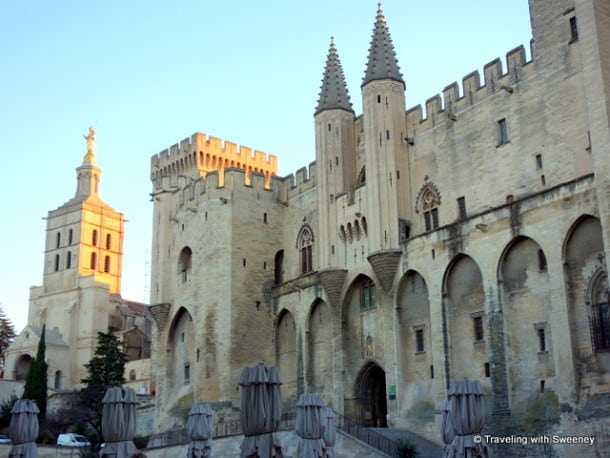
Editor’s note: In September, Catherine Sweeney will be teaming up with Je Suis. Paris to co-host a tour of the French capital for women. Check out this page for more on “A Boomer in Paris.”
What do popes, an ancient stone bridge and a Roman arena have in common? There are many possible answers—such as Rome—but after my recent trip to the Provence region of France, what comes to my mind are the UNESCO World Heritage Sites in the historic city centers of Arles and Avignon.
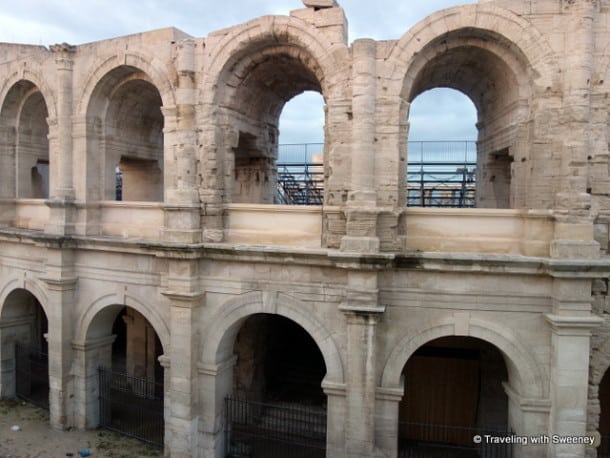
Arles: City of the Romans
Winding my way around the charming city center of Arles, famously known as creative inspiration for Vincent Van Gogh, I saw intriguing medieval buildings and other historic sites in every square and on every street. But among the most stunning scenes were those of the ancient Roman ruins, dating back to the 1st century B.C., which have earned Arles a UNESCO World Heritage Site inscription in recognition of its Roman and Romanesque monuments.
I was surprised to see this striking view (above) of the 1st-century-B.C. Roman arena and amphitheater from the window of my room at Hotel and Spa Calendal in Arles.

The juxtaposition of the arena with the old, yet much newer, architecture creates a dramatic effect, especially at night.
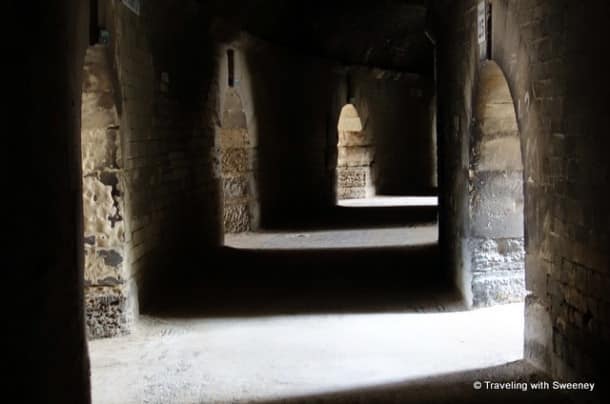
Gladiators fought to the death and chariots raced before crowds of 20,000 spectators in the arena. The impressive architecture of the arched passageways where people entered gave me an eerie feeling knowing the violence they would have been cheering inside.

Did you know that there is bullfighting in France? During my Provence visit, I learned about the strong Spanish ties of the region, clearly illustrated in the bullfights (some to the death) still held at the Roman arena from late spring to early fall.
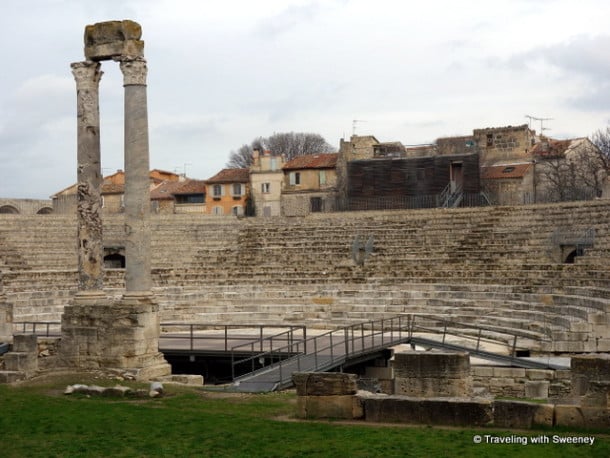
The Roman theater (above) also dates back to the 1st century B.C. Much of the theater’s original stone was removed and used for other construction in Arles over the centuries, but two columns, spectators’ benches and marble flooring remain. Many excavated relics from the theater are in the Arles Archaeological Museum, and the most famous piece, the Venus d’Arles, is in the Louvre.
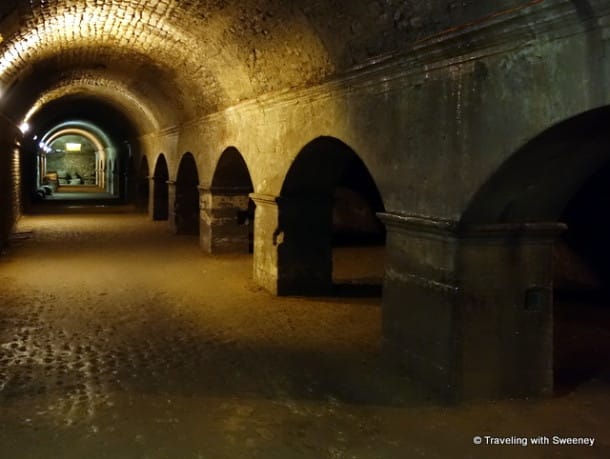
I also went underground in the U-shaped Cryptoporticos, underground galleries built in 30-20 B.C. that formed the foundation of the ancient forum.
Parts of the forum’s columns can still be seen on the facade of a building (below left) on the Place du Forum. Other sections (some pictured above at the end of the corridor) are in the Cryptoporticos . Today, City Hall (which provides the entry to the Cryptoporticos) and the Chapel of the Jesuit College are located above the foundation.
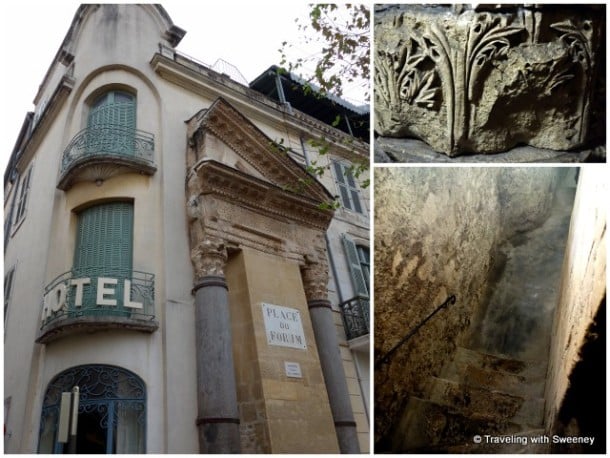
Arles thrived for centuries after the Romans, as evidenced by other historic sites also acknowledged by UNESCO designation. The Church of St. Trophime and its cloister (shown below) were built in the 12th century and are considered to be masterpieces of Romanesque architecture. Today, the cloister is used for special events such as the international santon-makers fair which showcases the art and craft of santons, important elements of Christmas traditions in Provence.
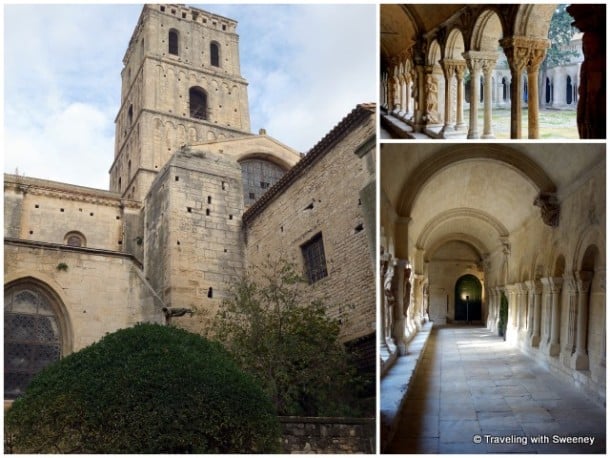
Other sites contributing to Arles’s UNESCO designation are the ramparts, the Roman baths and the graveyard of Les Alyscamps (outside the city center), depicted in paintings by Van Gogh and Gaugin.
The Romans loved the city of Arles so much that they continued to build, growing Arles into the second largest city after Rome. So prolific was their building that ruins and evidence of early Roman civilization are still being discovered, often delaying new construction as archaeologists examine the new findings.
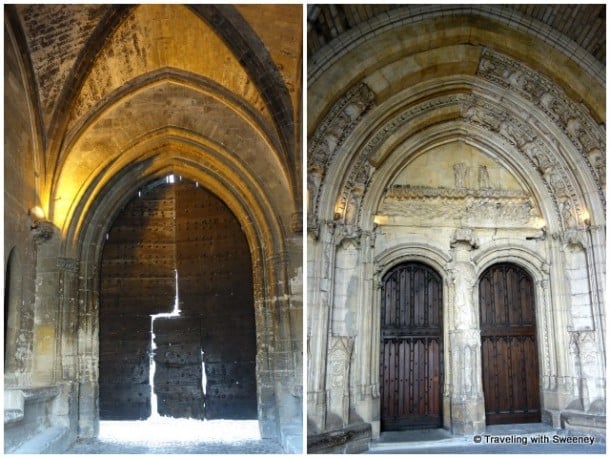
Avignon: City of the Popes
Most people associate popes with Rome. But a very important part of papal history lies in Avignon. I’d heard references to popes and Avignon, but I’d never really understood the significance. During my visit, I learned the fascinating story, which is key to Avignon’s designation as a UNESCO World Heritage Site.
In the 13th century, the King of France had a bitter feud with Pope Boniface VIII. On the death of Pope Boniface and, months later, the death of his successor, a Frenchman (Clement V) was elected and he chose to stay in France rather than move to Rome. During the 14th century (1309 to 1377), seven popes lived not in Rome but in the Palais des Papes (Palace of the Popes) in Avignon. As the city then became a major capital of the world, the population rose from about 5,000 to well over 30,000.
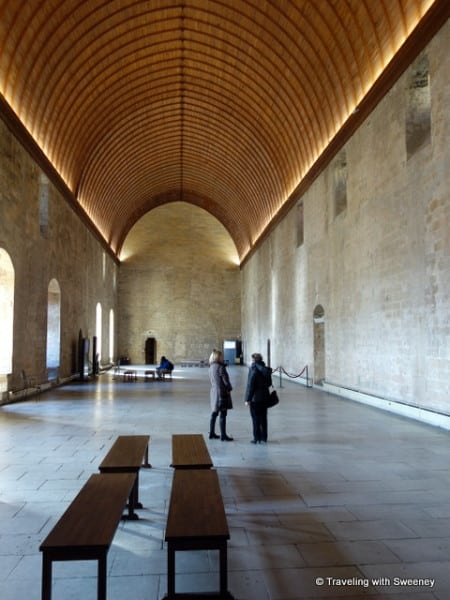
The largest Gothic palace (15,000 square meters) in Europe (surrounded by 4.5-km ramparts), the palace took 20 years to build during the papacies of Benedict XII and Clement VI. The 25 rooms open to the public include the private apartments of the pope and grand rooms for formal ceremonies and banquets. The adjacent Romanesque Cathedral of Notre Dame des Doms is also included in the UNESCO World Heritage inscription.
![Mosaic tiles, frescoes and sculptures (St. Catherine of Siena [right] was instrumental in bringing the papacy back to Rome)](https://johnnyjet.com/wp-content/uploads/2015/02/Palais-des-Papes-art-610x458.jpg)
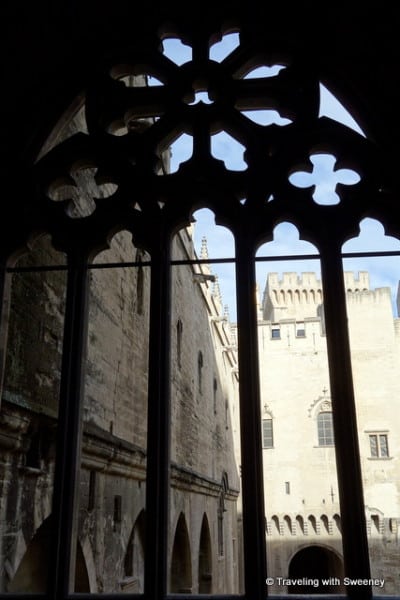
Below is one of my favorite scenes from inside the palace, in which I could imagine the popes sitting and gazing through the window at the Provençal countryside.

Completing the trio of sites included in the Avignon UNESCO World Heritage Site designation is Pont Saint-Bénézet, known as Pont d’Avignon. It was originally built with wood in the 12th century and rebuilt in stone in the 13th century. Repetitive flooding of the Rhône River continued to damage the bridge and now only four of the original 22 arches remain.
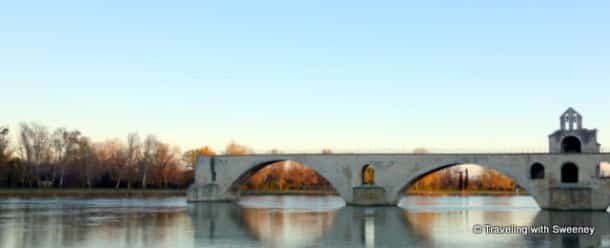
Although I hadn’t heard of it before this trip, there is a 15th century children’s song about dancing on the Pont d’Avignon that adds to the allure of the old bridge.
There are many reasons to visit the cities of Arles and Avignon, but the UNESCO sites are their crown jewels.
For more information about visiting Provence:





Wonderful post Cathy! You are amazing in tracing the past. It’s such a pleasure to read about the Roman remains in France and the ties between these two countries. Fascinating!
Thanks for that nice compliment, Agata. One of the things that my husband and I enjoy most about travel is delving into the history of places. There are always surprises!
I never associated France with bullfighting but I did know the children’s song about the bridge. We used to sing it in French growing up. Sur la pont, D’Avignon….
The bullfighting was big news for me, especially in that it’s still done today — some of them to the death.
Arles and Avignon were two favourites on our family trip to Provence. I particularly liked the bridge in Avignon because I also remember singing about it in French class in school. I talked my younger daughter into dancing on the bridge with me but the teenager would have no part of it!
I really must put a return visit to the bridge on my list so that I can dance on it, too. It was a little chilly in December for that. Maybe Spring for that next trip….
The history of this area in Provence is so interesting. Avignon is a favorite of mine, too. The empty moat and the lowered drawbridge coming from the walls of the city give you a glimpse of Avignon’s history right as you enter the city. I loved the Palais des Papes and the surrounding Roman ruins. The city of Nimes also offers some fantastic Roman ruins as well!
You’re right, it’s quite dramatic entering the city of Avignon after driving along the walls outside. In fact, we missed the entrance for the big modern parking inside the gates and ended up driving around the very narrow, winding streets throughout the city trying to get back to it. It was a little scary. Thanks for the Nimes tip.
Great article Cathy. It really makes me want to visit this area of France.
Love this, Cathy. My kind of trip. Lots of history and much in Arles and Avignon to hold my interest.
That there’s bull fighting surprised me at first but as you said – and I remembered from my semester in Spain – there is a strong connection between the two countries.
Sur le pont d’Avignon, On y danse, on ye danse. Brings back memories of French classes. Didn’t know it was so old.
I’m beginning to think that I’m the only one who didn’t know about the song before visiting Avignon. I guess I missed that day in French class.
Congrats on a great post which I stumbled on !
My wife Pascale and I live in Domazan, a small and friendly wine making village next to Avignon and Arles. We love the way in which this area enables you to live in natural surroundings which are filled to the brim with history…
As a further tip to those wishing to come to the are, check out the Pont du Gard and Uzes… Both are very close and WELL worth the trip :-)… besides this, If anybody is looking for a nice place to stay, we have a holiday appartment we rent on flipkey and airbnb.
A bientôt, enjoy your trip !
Robert
Glad you stumbled upon the post! It’s nice to get a local’s perspective. I think it would be amazing to live in that area. Thanks for the tips about other sites to see.